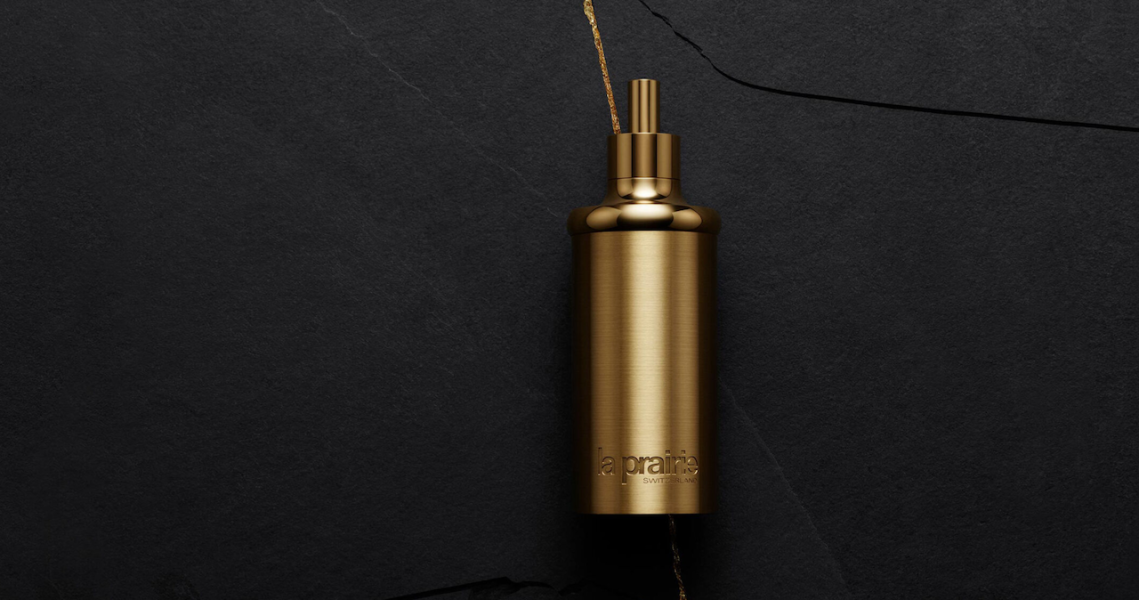This story is part of Glossy’s Earth Week series, which spotlights sustainability efforts and topics across the beauty and fashion industries. You can read some of our other coverage here and here.
Though sustainability is becoming a bigger priority for the beauty industry, luxury lines have largely relied on refillable models to marry consumer desire with brand positioning.
This week, La Prairie pre-launched its Pure Gold collection on its e-commerce site. It will debut at partners Neiman Marcus and Saks Fifth Avenue, among others, on May 3. The three products that are flecked with gold particles are refillable and range in price from $635-$850. They include a concentrate serum, an eye cream and a face cream, Greg Prodromides, La Prairie CMO, said the offering was the brand’s first “expression of sustainable luxury to embrace our responsibility to make the world a better, more beautiful place.” The products are encased in a brushed metal casing and cap, as well as a glass vial. To encourage shoppers to grow accustomed to a replenishing behavior, La Prairie beauty advisors have been instructed to show customers how to refill the products at all points of sale. The launch, which is replacing the brand’s Radiance Collection, also ties in with La Prairie’s ongoing patronage of the Glaciology Section at ETH Zurich to support glacier-related research.
Founder-led Susanne Kaufmann is another beauty brand that announced its refillable ambitions this spring. Kaufman has revamped the glass bottle packaging her brand is known for, in partnership with global plastic packaging manufacturer ALPLA. Her three best-selling products, a cleansing gel, a hand soap and a shower shampoo, will now feature 75% recycled high-density polyethylene packaging that is 100% recyclable post-use. The products range from $43-$82.
The reason for the Susanne Kaufmann transformation is because, while the brand’s existing glass bottles were indeed refillable, they were heavy to transport via air or ground freight. However, the new refill packs are up to 60% lighter than standard bottles, which reduces carbon emissions by 69% during production, transport and the post-consumer recycling process, said Kaufmann. Susanne Kaufmann is the first beauty brand that ALPLA has partnered with on this packaging innovation.
“There has been a long-standing perception that luxury products and sustainability must be mutually exclusive, which I do not believe to be the case,” said Kaufmann “In many cases, implementing more sustainable manufacturing and business practices is not always the most cost-effective option. However, it is very important to us that we make the most ethical and eco-conscious choices that we can, to lead by example and work toward a brighter, greener future.”

Ad position: web_incontent_pos1
Kjaer Weis, meanwhile, has already launched three refillable products this year, including its Eye Shadow Quadrant, FeatherTouch, Brow Gel and Matte Naturally Liquid Lipstick.
“When Kirsten [Kjaer Weis] founded the brand ten years ago, she was the first to bring to market high-performance, certified organic, luxury beauty products that were all presented in refillable packaging,” said said. “She created this category and set a new standard, not just in product manufacturing and performance, but also in sustainability. As a brand, we have been committed to this for over a decade, and the rest of the industry is now, thankfully, catching up,” said Gillian Gorman Round, CEO of Kjaer Weis.

Thus far, luxury beauty brands have focused their refillable efforts on limited assortments, as they try to teach customers new behaviors and keep packaging costs low.
For her part, Kaufmann said the actual process of refilling these products is not difficult: customers can do this at home by removing the pumps from the original glass bottle, cutting the opening cap of the refill with scissors and pouring the contents into the existing bottle. She incorporated this feature into the brand’s best-sellers to show the company’s commitment to refillable options. Kaufmann plans to add more products to the refill system in the second half of this year.
Ad position: web_incontent_pos2
Tata Harper is another brand that is trying to expand its refillable footprint. The brand’s only option currently is its Water Lock Moisturizer, which is $68 for the first product and $62 for a refill. Founder Tata Harper said others are in the works, but the process has been long and detailed.

“When designing the packaging, we had to conceptualize everything, from the refill pod to the components needed to keep the formula air-tight for freshness,” said Harper of the Water Lock Moisturizer. “Each step of the process came with unique challenges, but we are so proud to have finally created our first reusable packaging system. I believe the future is reusing your packaging, which is even better than recycling. This isn’t throwaway beauty, it’s reusable beauty. The reality is that beauty packaging can definitely be used longer. Think about all of your pumps, caps and jars — it’s not like these are disintegrating after a month or two of using.”
But even with more adoption from brands, the cost of producing these state-of-the-art refillable solutions is not getting cheaper, said Gorman Round. “We do not see the costs of sustainability being lower; it is not becoming more affordable at the luxury end of the market. But it is increasingly a necessity in the purchase decision of a luxury consumer,” she said.
Kjaer Weis has another refillable option that is launching in September, said Gorman Round, adding that it’s “a true first to market. This classic makeup product is almost impossible to manufacture in an environmentally responsible and sustainable way, and yet we have found a way.”
The question now remains if luxury customers will adopt a ritualistic refillable practice for all of their beauty products. Gorman Round believes they will, based on her experience at Kjaer Weis. “Twenty percent of our business online at KjaerWeis.com is in refills for previously purchased packaging. The retention rate is exceptional. at over 30% in the same period,” she said. “It is exponentially higher on an annual basis.”




